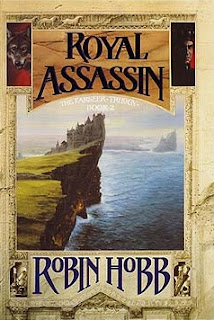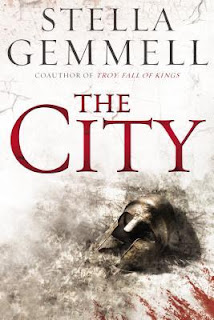Richard Ford originally hails from Leeds in the heartland of Yorkshire,
but now resides in the Wiltshire countryside. His debut novel Kultus was
released in 2011. His second novel Herald of the Storm hit
shelves in April 2013 and is available in the UK everywhere.
WBR: Hi Richard – Welcome to
Wilder’s Book Review, and our first ever interview!
RF: It’s great to be here, Doug.
I’ve not felt this honoured since I won the Swindon and District Ferrero Rocher
eating championships back in 2001.
WBR: First up – give us three
words that best describe your new book.
RF: Bloody. Bawdy.
Brilliant.
Too much alliteration?
WBR: Well I've already read it
and it certainly lives up to those descriptions! But for those that
haven't, can you tell us a little more about your new series Steelhaven and
the first book, Herald of the Storm.
RF: It’s an epic fantasy
series set entirely within the capital city of Steelhaven and told from
viewpoint of seven disparate characters, from the heir to the throne down to a
struggling street thief. The city itself is under threat of siege as the country
comes under attack from the north, and as things begin to unravel on the
frontline, they’re not going so well back at home either.
WBR: What was the idea behind Steelhaven and
your motives for writing it?
RF: I wanted to do
something quite sweeping and character-driven. I’d also been watching a lot of
quality TV shows like Breaking Bad and Mad Men, which have a lot of characters
but still manage to tell a cohesive story. Rather than just the usual kings-and-knights-and-barbarian
hordes kind of malarkey, I thought I’d focus on the little people too, and show
how they get by while the major players are doing their thing. Most of the main
action – the battles and nation-changing events – happen off-screen, but there’s
still plenty of murder and mayhem back home too.
WBR: The city of Steelhaven is
absolutely central to the first novel, and presumably the rest of the series –
what was your main reason for focusing on one city to such a
degree?
RF: First and foremost it helps
keep the book focused and stops it meandering off. The fantasy quest saga is
getting a bit tired, so there was no way I was going there. I wanted the series
to culminate in a siege, so letting the reader get to know the city as much as
the characters gives them a kind of emotional investment in the place… before I
burn it to the ground!
WBR: So would you say you're
playing around with the tropes a little, taking all the elements of epic
fantasy but minimising the setting and concentrating the focus of the story?
RF: I've previously blogged a bit
about worldbuilding and my hatred of it here. However, that was before I'd started on the Steelhaven series in earnest. Since
then it's become obvious that an epic fantasy writer who disregards their
worldbuilding is just asking for trouble. Saying that, you're right about
concentrating the focus on story, and in particular character. You can have all
the intricate worldbuilding you want, but if you're characters are two
dimensional and your story lacking any edge, your novel is bound to fail.
WBR: Herald of the Storm
appears to focus on what's happening at home on the sidelines while the
big adventures happen "over there" - was this an intentional focus of
yours in writing this book?
RF: I guess it was. There's an
invading army and the king goes out to face it. In 9 out of 10 epic fantasy
novels this would be the main focus, but I wanted to concentrate on Steelhaven
and its story. Anyone who likes epic battles shouldn't be put off though,
there's plenty of that still to come later.
WBR: Will we see more of the
world outside of Steelhaven in future books?
RF: The first three books
will be set mainly within the city. Beyond that, who knows, but I’d definitely
like to stretch my wings a bit.
WBR: You have quite a diverse
set of point-of-view characters in Herald of the Storm - were
each of them planned from the outset, or did they come up organically during
the writing process? Do you plan on expanding the core cast in the future?
RF: Most of the characters
evolved with their own stories. When I was planning the series it suddenly hit
me that I could probably amalgamate their differing story arcs into one
overarching plot, and they would all cross over at some point. This can be
quite tricky, and I have been known to plot a chapter breakdown in Excel before
now.
The sequel to Herald
of the Storm will see a new major character introduced but I think
eight core characters are enough for now. Too many POVs can lead to a novel
losing its focus and meandering off on meaningless tangents. I’d like to avoid
that if at all possible.
WBR: What were your main
influences behind the book?
RF: I originally pitched
the series as ‘David Gemmel’s Legend meets HBO’s The Wire’ and I think they’re
the main two. Obviously, as all writers are, I’m influenced by everything I see
and hear in a variety of media, be it novels, TV, comics, film or computer
games. Writers find source material everywhere they look, and I like to steal
things… erm… borrow things wherever I can.
WBR: You also have another book
out, published by Solaris, titled Kultus. Can you tell us a little
bit about it? Is this a series you are likely to return to somewhere down the
line?
RF: Kultus is
an all-action, balls to the wall, adventure novel. A Jason Statham
movie-in-a-novel for steampunk fans, if you will. In particular it was
influenced by several hardboiled characters from 2000 AD, which I was obsessed
with as a kid. It’s my homage to Judge Dredd, Johnny Alpha, Slaine and Rogue
Trooper.
I’d certainly love to write a
sequel – in fact I’d planned it as a series of novels – but at the moment I’m
mainly focused on Steelhaven. Who knows, maybe one day Thaddeus Blaklok will
rear his big ugly head once again.
WBR: That's good to hear - I
know of a lot of people who want to see the return of Thaddeus!
WBR: What’s next for Richard
Ford?
RF: Book two in the
Steelhaven series approaches completion of its first draft. Then it’s the
never-ending cycle of edits as I tear more hair out trying to make a jumbled
mass of words into a coherent reading experience. Not that I’ve got much hair
left to tear.
WBR: Do you have a tentative
release date for the next book as of yet?
RF: We're aiming for a year
between releases, so it'll be around April 2014.
WBR: Finally, what are you
reading right now?
RF: I’ve nearly finished The String Diaries by Stephen
Lloyd Jones (which isn’t out yet, but being a fellow Headline author I got an
advanced copy). It’s brilliant too, highly recommended.
WBR: Thanks Richard!
Kultus by Richard Ford is also available now and is published by Solaris.
You can read my review of Herald of the Storm here.


















